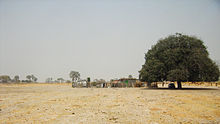Kraal

A kraal (or Kral , Afrikaans , from port. Curral for, Viehpferch ') was originally a circular settlement with a strictly regulated social structure. There were kraals mainly in southern Africa . They were mostly surrounded by a palisade-like wall of thorns.
Today only the cattle pen that used to be in the middle of the settlement is called kraal. However, the word can still be found from time to time in place names in South Africa .
Southern Africa
The social structure within a kraal was strictly patriarchal , that is, such a settlement was run by the family father. His wives with their children each lived in their own hut, which was mostly arranged around the cattle kraal. This arrangement was particularly common among the Zulu in Natal . Other relatives could also live in the kraal , who had to submit to the management of the head of the family , whose authority was secured by tradition. The importance of a kraal depended on the status of the headmaster (see below ).
This structure can also be seen as the cornerstone of the social and economic order at that time. Several kraals formed a loose association under one chief . Several of these alliances were subordinate to a chief chief, over whom another high chief or, in the heyday of an African tribe, even the king stood.
King kraal
In contrast to the purely civilian settlements, a royal kraal was a military facility to protect the ruler.
Such kraals were mostly oval and surrounded by a palisade of strong stakes. However , they had little strategic influence on the conflict between the indigenous peoples and the white immigrants. However, they were all the more important when fighting tribal feuds.
Royal kraals were mainly common among the Zulu and Matabele .
Fish kraal
The word is also used as a term for an efficient fishing method used by the Tsonga . This is a kind of trap , but with larger dimensions. With the help of branches, a channel is built, at the end of which there is a basket with a valve-like entrance. Fish can swim into this basket, but no longer swim out.
This type of fishing occurs in Kosi Bay .
East Africa
Among the nomadic Maasai people , kraal is also a small collection of huts. However, this does not have to be a permanent settlement like in southern Africa, but the village can also consist of huts that are more or less easy to assemble and dismantle.
In a kraal, one extended family lives together, which is headed by an older male head of the family. In addition to the father's wives, the family also includes the married sons. The women take care of the construction of the huts and the repairs that arise. Every woman here also has her own hut.
Asia
In Sri Lanka , India and Thailand , enclosures for elephants are also known as kraals.
Other countries
In the old spelling Kral , the news magazine Der Spiegel described the New York borough of Harlem as the "largest Negro kraal in the world" in 1965 after race riots . The use of the word in this context suggests a pejorative connotation.
In the prologue of his experience report, which covers the years of the Second World War, Percy Gurwitz describes the spatial coexistence of Latvians, Germans, Russians and Jews in Riga in the interwar period with the metaphor of the kraal: “So the peoples of Latvia did not live together, but at best side by side, and it there was more enmity and strangeness between them than friendship and mutual bond. […] You spent your life inside a kraal and only rarely peeked over the hedge to the neighboring kraal. Despite the brisk business and professional intercourse, social interaction between members of different nationalities was a sensational exception. "
literature
- Potgieter, DJ (Ed.): Standard Encyclopedia of Southern Africa . 1st edition. Nasionale Opvoedkundige Uitgewery Ltd., Cape Town 1972, ISBN 978-0-625-00322-8 .
- South Africa's north and east coast . 1st edition. Reiseuchverlag Iwanowski, Dormagen 2006, ISBN 3-933041-18-X , p. 521 ( limited preview in Google Book search).
- Brockhaus encyclopedia . 21st edition. Brockhaus FA, Mannheim 2006, ISBN 3-7653-4115-0 (Volume 15).
- The New Encyclopædia Britannica . 15th edition. Encyclopædia Britannica, Inc., Chicago 2007, ISBN 978-1-59339-292-5 (Micropædia, Volume 6).
See also
Web links
Individual evidence
- ↑ The ugly negro. Der Spiegel , August 25, 1965, accessed on January 29, 2013 .
- ↑ Percy Gurwitz: Don't just count what was bitter. A Baltic Chronicle of Jews and Germans , Verlag Neues Leben, Berlin 1991, ISBN 3-355-01345-5 , p. 9 u. 10

